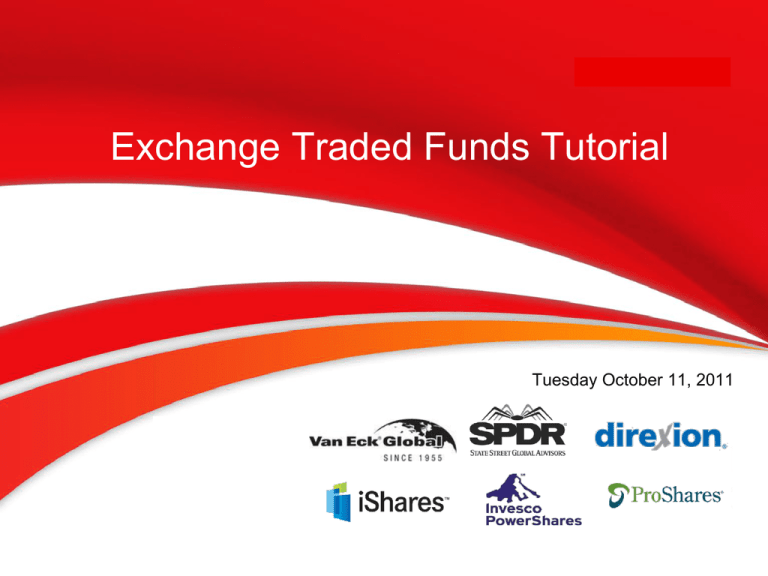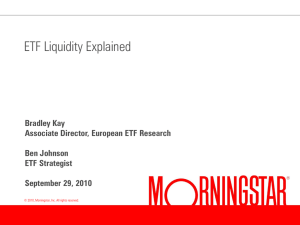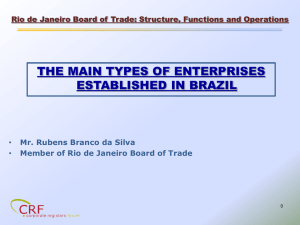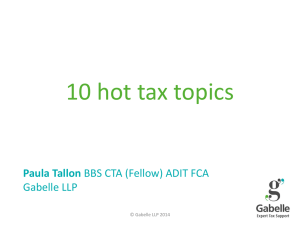
Exchange Traded Funds Tutorial
Tuesday October 11, 2011
Panel
Moderator
– Brian Gabelman, Director of Prime Finance ETF Trading, Citi
Panelists
– Timothy Coyne, Vice President/Global Head of ETF Liquidity Management,
State Street Global Advisors
– Michael Crinieri, Managing Director, Goldman Sachs & Company
– Adam Gould, SVP/Business Development, Direxion Funds
– Michael Cardieri, Vice President, JP Morgan Chase & Company
– David Mann, Director, Blackrock Inc.
2
Agenda
Overview
– Authorized participants
– ETF providers and assets
– Customers driving demand
Current Trends and Future Trends
– Competition
– ETFs vs. Mutual Funds
Creation/Redemption
– Flows and rebalancing
Types and Strategies
Securities Lending
– Sources and types of supply
– Recalls
– Trends
Regulatory Issues
– Can an ETF collapse
– Potential new regulations
– Synthetic
– ETNs vs. ETFs
– Fixed Income and Equity
– US listed vs. local listed
– Leveraged
3
Overview & Current/Future Trends
Overview
– Authorized participants
– ETF providers and assets
ETF Trends
– Fixed Income
– Active ETFs vs. passive ETFs
– Global expansion
– Evolution of products
Competition
– New ETF entrants
– Increasing number of ETFs not gathering assets (ETF closures)
ETFs vs. Mutual Funds
– Relative growth
– Impact on mutual fund assets and the securities lending market
– Growth projections for ETFs and client breakdown
4
US ETF Growth in Assets and Funds
Assets as of June 30, 2011
1200
1100
$1,000
900
$800
800
700
$600
600
500
$400
400
300
$200
200
100
$0
0
2001
2002
2003
2004
2005
2006
Assets
2007
2008
2009
2010
# of Funds
There are now 1,105 ETFs with approximately $1.08 trillion in assets
153 ETFs have been launched in 2011
Source: SSgA Strategy & Research, Bloomberg, as of 6/30/2011
2011 YTD
# of ETFs
Asset in Billions
1000
Diversification of the US ETF Market
Institutions now have access to a wide range of ETFs across various asset classes
Fixed Income ETFs
represent 13.7% of
ETF assets
$1,200,000
Assets ($ MIL)
$1,000,000
$800,000
$600,000
Nov. 2004: Launch of the
first commodity ETF
$400,000
$200,000
$0
2000
2001
2002
2003
2004
2005
2006
2007
2008
2009
2010
2011
Year
US Equity
Commodity
Source: State Street, Bloomberg, as of June 30, 2011
CMIBG-0226
Currency
Fundamental
Fixed Income
Global/International
Specialty
US ETF Asset Projections 2009E–2013E
Cerulli estimated that US ETF assets would surpass $1 trillion by the end of 2010
(actual ETF assets closed 2010 at $995 billion)
$2,000
$1,866
$1,800
$1,556
$1,600
$1,400
$1,276
$1,200
$1,023
$1,000
$800
$767
$600
$400
$200
$0
2009E
Source: Cerulli, as of 12/31/2009
2010E
2011E
2012E
2013E
APs Create and Redeem ETFs
Authorized Participant (AP)
Create
ETF
Ticker
Shares
OGZD LI
15,000
PKX US
4,246
SMSN LI
2,200
Redeem
ETF
150,000
shares of
EEM
150,000
shares of
EEM
Ticker
Shares
OGZD LI
15,000
PKX US
4,246
SMSN LI
2,200
ETF Trust/Fund
For illustrative purposes only
8
Types and Strategies
Equity
– Sector ETFs
– Index based ETFs (Dow Jones, S&P, Russell)
Fixed Income
– Creation/redemption
– 3 baskets vs. 1 basket
International ETF
– Stamp tax
– Country ETFs
– Dividend withholding
– Settlement issues
Local ETFs
– Tax issues
– Growth
– Undeveloped markets
9
Considerations for ETF Create-to-Lend Activity
Impact of Index Rebalancing Events on ETF Lending
The majority of ETFs passively replicate published indices.
ETF positions created for lending are frequently hedged with the ETF constituents,
resulting in a need to rebalance the hedge when indices make changes.
Index rebalancing events, share increases and decreases, and other corporate actions
can all lead to a reevaluation of the hedge.
Impact of Stamp Tax, Dividend Withholding for International ETFs
Some countries impose a stamp tax on securities transactions that apply when there is a
change in beneficial ownership, which may increase costs for ETFs with international
equities.
Different tax rates and withholding may apply to dividends and interest paid depending on
the domicile of the investing fund.
Source: FactSet, Reuters, Bloomberg and Goldman Sachs. As of 12/31/2009.
10
% Short Interest/Assets
Short Interest Trends Highlight ETF Hedging
55
50
45
40
35
30
25
20
15
10
5
0
ETFs are frequently used to hedge unwanted exposures or to implement active macro
views.
Because they cover more indices and exposures than listed futures, they are particularly
effective for adjusting sector, style, and cross-asset exposures.
Recent trends in reported short interest are consistent with the investment strategies that
were prevalent in 2011 year-to-date.
Broad-based US equity exposure is currently the most heavily shorted category of ETFs.
%Short
Sector ETFs are also heavily shorted relative to their assets.
interest/
1Jan2008
2008
Jan
Short interest as % of Assets
2009
Jul
Jan
2010
Jul
Jan
6Oct2011
2011
Jul
Jan
Jul
Highest short interest in US$
SPY
S&P 500 SPDR
IWM
Russell 2000 iShares
QQQ
Nasdaq-100
XLE
Energy Select Sector SPDR
GLD
Gold Trust SPDR
Highest % short interest/assets*
XRT
Retail SPDR
XOP
Oil & Gas Explor & Prod SPDR
FXE
CurrencyShares Euro Trust
KRE
KBW Reg Banks SPDR
VXX
S&P VIX Short-term Futures ETN
US$ mm
$65,118
$19,709
$6,541
$4,774
$4,572
assets
70%
144%
30%
65%
6%
$4,449
$2,693
$502
$1,106
$823
741%
311%
271%
262%
221%
*Exclusive of HOLDRs
Levered/inverse Sector Fixed Income Commodity Currency International
US equity (large/mid/small cap) US equity style/fundamental
Source: Goldman
Bloomberg,
Reuters(NYSE),
For illustrative
purposes
only . As
of 9/15/11
Source: Sachs,
New York
Stock Exchange
Bloomberg
and Goldman
Sachs.
As of 11/30/09.
11
Stock Short Interest Exceeds ETF Short Interest
Although some ETFs have reported short interest levels that exceed their assets, they
are less susceptible to short squeezes because more ETF shares can be created from
the underlying constituents.
If ETF short interest is compared with the short interest of the underlying constituents in
notional terms, or as a percent of total underlying market capitalization, it is clear that the
magnitude of the ETF short interest is much less than the short interest in the underlying
stocks.
Equity ETFs with highest ETF Short int/assets (%)
XRT
XOP
KRE
Retail SPDR
Oil & Gas Explor & Prod SPDR
KBW Reg Banks SPDR
Other ETFs
SPY
S&P 500 SPDR
IWM
Russell 2000 iShares
ETF short int/
ETF assets (%)
Reported short
interest ($mm)
ETF
Total stock
ETF short
Stock short
interest/
interest/
Stock market cap (%)
741%
311%
262%
$3,234
$2,665
$1,136
$30,850
$19,789
$4,819
0.55%
0.38%
1.73%
5.27%
2.80%
7.32%
70%
144%
$65,118
$19,709
$278,778
$98,331
0.58%
1.59%
2.48%
7.94%
12
Source: Goldman
Bloomberg,
Reuters(NYSE),
For illustrative
purposes
only . As
of 9/15/11
Source: Sachs,
New York
Stock Exchange
Bloomberg
and Goldman
Sachs.
As of 11/30/09.
Leveraged ETFs
Direxion ETFs
– Introduction
– Usage of leveraged ETFs
– Assets under management
– Long-term vs. short-term holdings
Rebalancing
– Daily rebalancing
– Volatility impacting the close
Creation/redemption
– Process
Strategies
– Shorting
– Hedging
– Bear funds in lieu of puts
– Leveraged vs. borrowing/shorting one beta ETFs
– Option writing
13
Leveraged ETFs (cont’d)
350
Index
Rises 1%
350
$303
$300
300
300
250
250
200
200
150
150
$300
$103
$100
100
100
50
50
0
Total Exposure
$100
ETF Assets
$303
$103
0
ETF Assets
Index
Declines 1%
Total Exposure
= 294%
Bull and
Bear Fund
Exposure
Changes
Index Rises 1% ($3 Gain)
1
Initial Allocation
and Exposure
2
Index Rises 1%
1. Initial Allocation and Exposure: A 3x Bull Fund ETF with $100 in net assets starts the trading day
with $300 of net exposure to the benchmark index
2. Index Rises 1%: If the index rises by 1% from the prior close, the gross exposure would rise to
$303 and net assets would rise to $103 causing the total exposure level to decrease to 294%
At the close Direxion needs to invest $6 at the close in order to return fund exposure to 300%
14
Source: Direxion
Securities Lending
Sources of Supply
– Agent Lender
Pension Funds
Mutual Funds
Endowments
Broker Dealers
– Internal trading desk
– Prime Brokerage
– Retail (margin/fully paid)
Type of Supply
– Agent Lender
Widely held broad based ETFs (SPY, QQQ, MDY, IWM, EEM)
– Broker Dealers
Broad based ETFs
Sector ETFs (XRT, XOP, IYR, IEO)
Leveraged ETFs (FAZ, FAS, BGU, BGZ)
15
Securities Lending (cont’d)
Demand for Borrow
– Hedging
– Directional plays
Index
Sector
Country
Rebate Rates
– Supply and demand
– Creation costs
– Dividend and rebalancing – increased borrow cost
Recalls
– Dividend record date
– Index rebalancing
– Unstable supply (retail & market maker supply)
Trends
– Current
– Future
16
North American ETFs Value on Loan
(USD Millions)
60,000
640
620
50,000
600
580
30,000
560
FTF Count
Value on Loan
40,000
20,000
540
10,000
520
Value on Loan (USD)
Source: Data Explorers
06-Sep-11
06-Aug-11
06-Jul-11
06-Jun-11
06-May-11
06-Apr-11
06-Mar-11
06-Feb-11
06-Jan-11
06-Dec-10
06-Nov-10
500
06-Oct-10
0
ETFs with Activity (Count)
17
North American ETFs Lendable
70,000
700
60,000
600
50,000
500
40,000
400
30,000
300
20,000
200
10,000
100
Lendable Value (USD)
Source: Data Explorers.
06-Sep-11
06-Aug-11
06-Jul-11
06-Jun-11
06-May-11
06-Apr-11
06-Mar-11
06-Feb-11
06-Jan-11
06-Dec-10
06-Nov-10
0
06-Oct-10
0
FTF Count
Value on Loan
(USD Millions)
ETFs with Lendable (Count)
18
Source: Data Explorers.
Value on Loan (USD)
21-Sep-11
07-Sep-11
24-Aug-11
10-Aug-11
27-Jul-11
13-Jul-11
29-Jun-11
15-Jun-11
01-Jun-11
18-May-11
04-May-11
20-Apr-11
06-Apr-11
23-Mar-11
09-Mar-11
23-Feb-11
09-Feb-11
26-Jan-11
12-Jan-11
29-Dec-10
15-Dec-10
01-Dec-10
17-Nov-10
03-Nov-10
20-Oct-10
3,000
European ETFs
Value on Loan
2,500
220
1,500
500
0
ETF Count
06-Oct-10
Value on Loan
European ETFs Value on Loan
(USD Millions)
250
240
2,000
230
210
1,000
200
190
180
ETFs with Activity (Count)
19
European ETFs Lendable
12,000
300
10,000
250
8,000
200
6,000
150
4,000
100
2,000
50
Lendable Value (USD)
Source: Data Explorers.
06-Sep-11
06-Aug-11
06-Jul-11
06-Jun-11
06-May-11
06-Apr-11
06-Mar-11
06-Feb-11
06-Jan-11
06-Dec-10
06-Nov-10
0
06-Oct-10
0
FTF Count
Value on Loan
(USD Millions)
ETFs with Lendable (Count)
20
Synthetic/Regulatory Issues
Synthetic Issues
– Definition of ‘synthetic’ ETF
– Regulatory ETF overview of US (1940 Act) and Europe (UCITS)
– Risks highlighted in the Financial Stability Board Report
– Different ways to structure a synthetic ETF
– Reasons synthetics would be preferred
– Differences between an ETF and an ETN
Regulatory Issues
– Can an ETF collapse?
Examples of how short interest can exceed 100
Requirements of a redeeming AP
Discussion on short squeezes and the creation/redemption mechanism
Rule 204 of Reg SHO
Potential New Regulations
– SEC concept release on the use of derivatives in 1940 Act funds
– ETF Rule
21
Questions & Answers
Moderator
– Brian Gabelman, Director of Prime Finance ETF Trading, Citi
Panelists
– Timothy Coyne, Vice President/Global Head of ETF Liquidity Management,
State Street Global Advisors
– Michael Crinieri, Managing Director, Goldman Sachs & Company
– Adam Gould, SVP/Business Development, Direxion Funds
– Michael Cardieri, Vice President, JP Morgan Chase & Company
– David Mann, Director, Blackrock Inc.
22
Disclosure
For Investment Professional Use Only
Although the statements of fact and data in this presentation have been obtained from, and are based upon, sources believed to be reliable, SSgA
does not guarantee their accuracy, and any such information may be incomplete or condensed. All opinions included in this presentation constitute
the judgment of SSgA as of the date of this report and are subject to change without notice.
Important Risk Information
ETFs trade like stocks, are subject to investment risk, fluctuate in market value and may trade at prices above or below the ETFs net asset value.
Brokerage commissions and ETF expenses will reduce returns.
These investments may have difficulty in liquidating an investment position without taking a significant discount from current market value, which can
be a significant problem with certain lightly traded securities.
Passive management and the creation/redemption process can help minimize capital gains distributions.
Diversification does not ensure a profit or guarantee against loss.
Shares of the State Street ETFs are not insured by the FDIC or by another governmental agency; they are not obligations of the FDIC nor are they
deposits or obligations of or guaranteed by State Street Bank and Trust Company. State Street ETFs are subject to investment risks, including
possible loss of the principal invested.
The trademarks and service marks contained herein are the property of their respective owners. Third-party data providers make no warranties or
representations of any kind relating to the accuracy, completeness or timeliness of the data provided and not have liability for damages of any kind
relating to such data.
In general, fund shares can be expected to move up or down in value with the value of the applicable index. Although shares may be bought and sold
on the exchange through any brokerage account, shares are not individually redeemable from the Fund. Investors may acquire shares and tender
them for redemption through the Fund in Creation Unit Aggregations only, please see the prospectus for more details.
Trademark Disclosure
The SPDR Gold Shares Trust ("GLD") has filed a registration statement (including a prospectus) with the Securities and Exchange Commission
("SEC") for the offering to which this communication relates. Before you invest, you should read the prospectus in that registration statement and
other documents GLD has filed with the SEC for more complete information about GLD and this offering. You may get these documents for free by
visiting EDGAR on the SEC website at www.sec.gov or by visiting www.spdrgoldshares.com. Alternatively, the Trust or any authorized participant
will arrange to send you the prospectus if you request it by calling 1-866-320-4053.
Disclosure
Trademark Disclosure
The Russell/Nomura PRIMETM Index and Russell/Nomura Small CapTM Index are trademarks of Russell Investment Group and Nomura Securities Co., Ltd. and
have been licensed for use by State Street Bank and Trust Company through its State Street Global Advisors Division. The Products are not sponsored,
endorsed, sold or promoted by Russell Investment Group or Nomura Securities Co., Ltd. and neither party makes any representation regarding the
advisability of investing in the Product.
The MSCI ACWISM Index is a trademark of MSCI. The financial products described herein are indexed to an MSCI index. The financial products referred to
herein are not sponsored, endorsed or promoted by MSCI, and MSCI bears no liability with respect to any such financial products or any index which such
financial products are based. The prospectus contains a more detailed description of the limited relationship that MSCI has with SSgA and any related funds.
The Macquarie Global Infrastructure 100 Index is a trademark of Macquarie and has been licensed for use by State Street Bank and Trust Company through its
State Street Global Advisors Division. The SPDR® FTSE/Macquarie Global Infrastructure 100 ETF is not in any way sponsored, endorsed, managed, sold or
promoted by FTSE International Limited (“FTSE”), Macquarie Bank Limited or its affiliates or subsidiaries, the London Stock Exchange Plc (the “Exchange”)
or by The Financial Times Limited (“FT”). For further important information and disclaimers regarding Macquarie, see spdrs.com.
“Dow Jones®”, “The Dow®”, “Dow Jones Industrial AverageSM” and “DJIA®” are trademarks of the Dow Jones & Company, Inc. (“Dow Jones”) and have been
licensed for use by State Street Bank and Trust. The Products are not sponsored, endorsed, sold or promoted by Dow Jones and Dow Jones makes no
representation regarding the advisability of investing in the Product.
The Morgan Stanley Technology Index is exclusive property of Morgan Stanley. Morgan Stanley is a service mark of Morgan Stanley and has been licensed for
use by State Street Bank and Trust Company. Nuveen® is a registered trademark of Nuveen Investments, LLC.
SPDR KBW ETFs are not sponsored, endorsed, sold or promoted by Keefe, Bruyette & Woods (“KBW”). KBW makes no representation or warranty, expressly or
implied, to the owners of the SPDR KBW ETFs or any member of the public regarding the advisability of investing in securities generally, or in the SPDR
KBW ETFs particularly, or the ability of the KBW Indexes to track general stock market performance. KBW’s only relationship to State Street Bank and Trust
Company is the licensing of certain trademarks and trade names of KBW and of the KBW Indexes, which are determined, composed and calculated by KBW
without regard to State Street Bank and Trust Company or the SPDR KBW ETFs. KBW has no obligation to take the needs of State Street Bank and Trust
Company or the owners of the SPDR KBW ETFs into consideration in determining, composing or calculating the KBW Indexes. KBW is not responsible for,
and has not participated in, any determination or calculation made with respect to issuance or redemption of the SPDR KBW ETFs. KBW has no obligation or
liability in connection with the administration, marketing or trading of the SPDR KBW ETFs.
“Barclays Capital” is a trademark of Barclays Capital, the investment banking division of Barclays Bank PLC (“Barclays Capital”) and is used by State Street
Global Advisors under license. Barclays Capital compiles, maintains and owns rights in and to the Barclays US Government Inflation-linked Bond Index. The
SPDR Barclays Capital TIPS ETF is not sponsored, endorsed, sold or promoted by Barclays Capital. Barclays Capital or one of its affiliated entities may act
as an Authorized Participant and/or as an initial purchaser of shares of the SPDR Barclays Capital TIPS ETF. Barclays Capital makes no representation
regarding the advisability of investing in the SPDR Barclays Capital TIPS ETF or use of either the Barclays US Government Inflation-Linked All Maturities
Index or any data included therein.
Barclays Capital is a trademark of Barclays Capital, the investment banking division of Barclays Bank PLC (“Barclays Capital”) and has been licensed for use in
connection with the listing and trading of the SPDR Barclays Capital ETFs. The products are not sponsored by, endorsed, sold or promoted by Barclays
Capital and Barclays Capital makes no representation regarding the advisability of investing in them.
“Deutsche Bank” and “DB Global Government ex-US Inflation-Linked Bond Capped IndexSM“ are reprinted with permission. ©Copyright 2008 Deutsche Bank AG.
All rights reserved. “Deutsche Bank” and DB Global Government ex-US Inflation-Linked Bond Capped IndexSM are service marks of Deutsche Bank AG and
have been licensed for use for certain purposes by State Street Global Advisors. The SPDR DB International Government Inflation-Protected Bond is not
sponsored, endorsed, sold or promoted by Deutsche Bank AG. Deutsche Bank AG, as Index Provider, makes no representation, express or implied,
regarding the advisability of investing in this product.
The Wells Fargo® Hybrid and Preferred Securities Aggregate Index is a trademark of Wells Fargo & Company and has been licensed for use by State Street
Global Advisors. The product is not sponsored, endorsed, sold or promoted by Wells Fargo & Company or its affiliates and Wells Fargo & Company makes
no representation regarding the advisability of investing in this product.
Disclosure (cont’d)
"SPDR®" is a registered trademark of Standard & Poor's Financial Services LLC ("S&P") and has been licensed for use by
State Street Corporation. No financial product offered by State Street Corporation or its affiliates is sponsored, endorsed,
sold or promoted by S&P or its affiliates, and S&P and its affiliates make no representation, warranty or condition regarding
the advisability of buying, selling or holding units/shares in such products. Further limitations that could affect investors'
rights may be found in applicable prospectus.
SSgA® Funds is a service mark of State Street Corporation
Distributor: State Street Global Markets, LLC, member FINRA, SIPC, a wholly owned subsidiary of State Street
Corporation. References to State Street may include State Street Corporation and its affiliates. Certain State Street
affiliates provide services and receive fees from the SPDR ETFs. ALPS Distributors, Inc., a registered broker-dealer, is
distributor for SPDR shares, MidCap SPDRs and Dow Diamonds, all unit investment trusts and Select Sector SPDRs.
Before investing, consider the funds investment objectives, risks, charges and expenses. To
obtain a prospectus or summary prospectus which contains this and other information, call 1-866787-2257 or visit www.spdrs.com. Read it carefully.
Exp. Date 10/20/2011
SR-1514







